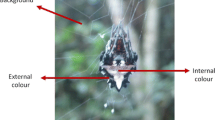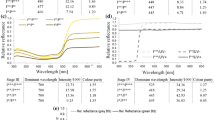Abstract
Many animals use body coloration as a strategy to communicate with conspecifics, prey, and predators. Color is a trade-off for some species, since they should be visible to conspecifics but cryptic to predators and prey. Some flower-dwelling predators, such as crab spiders, are capable of choosing the color of flowers where they ambush flower visitors and pollinators. In order to avoid being captured, visitors evaluate flowers visually before landing. The crab spider Mecaphesa dubia is a polymorphic species (white/purple color morphs), which inhabits the flower heads of a dune plant, Palafoxia lindenii. Using full-spectrum photography of spiders and flowers, we evaluated how honeybees perceived the spiders at different distances. Using visual modeling, we obtained the chromatic and achromatic contrasts of the spiders on flower heads as perceived by honeybees. Purple morphs were found mainly on the receptacle area and white morphs were equally likely to be found in the flowers and receptacle. According to theoretical modeling, white morphs were visible to honeybees from a distance of 10 cm in receptacle area but appeared to be cryptic in the flower area. Purple morphs were cryptic on the receptacle and less so when they were on the flowers. Spiders on flower heads are predicted to be more easily detected by honeybees using chromatic contrast. Our study shows that the conspicuousness of flower dwelling spiders to honeybees depends on the color morph, the distance of observation, and the position of spider on the flower head.




Similar content being viewed by others
References
Ajuria Ibarra H, Reader T (2013) Reasons to be different: do conspicuous polymorphisms in invertebrates persist because rare forms are fitter? J Zool 290:81–95. https://doi.org/10.1111/jzo.12034
Ajuria Ibarra H, Reader T (2014) Female-limited colour polymorphism in the crab spider Synema globosum (Araneae: Thomisidae). Biol J Linn Soc 113:368–383. https://doi.org/10.1111/bij.12338
Ajuria-Ibarra H, Tapia-McClung H, Rao D (2017) Mapping the variation in spider body colouration from an insect perspective. Evol Ecol 31:663–681. https://doi.org/10.1007/s10682-017-9904-5
Álvarez-Molina L, Martínez ML, Lithgow D, Mendoza-González G, Flores P, Ortíz-García S, Moreno-Casasola P (2013) Biological flora of coastal dunes and wetlands: Palafoxia lindenii A. Gray. J Coast Res 29:680–693. https://doi.org/10.2112/JCOASTRES-D-12-00146.1
Anderson AG, Dodson GN (2014) Colour change ability and its effect on prey capture success in female Misumenoides formosipes crab spiders. Ecol Entomol 40:106–113. https://doi.org/10.1111/een.12167
Avarguès-Weber A, Giurfa M (2014) Cognitive components of color vision in honey bees: how conditioning variables modulate color learning and discrimination. J Comp Physiol A 200:449–446. https://doi.org/10.1007/s00359-014-0909-z
Barnett JB, Cuthill IC, Scott-Samuel NE (2018) Distance-dependent aposematism and camouflage in the cinnabar moth caterpillar (Tyria jacobaeae, Erebidae). Royal Soc Open Sci 5:171396. https://doi.org/10.1098/rsos.171396
Bhaskara RM, Brijesh MC, Ahmed S, Borges RM (2009) Perception of ultraviolet light by crab spiders and its role in selection of hunting sites. J Comp Physiol A 195:409–417. https://doi.org/10.1007/s00359-009-0419-6
Bonte D, Jean-Pierre JP (2004) Colour variation and crypsis in relation to habitat selection in the males of the crab spider Xysticus sabulosus (Hahn, 1832) (Araneae: Thomisidae). Belg J Zool 134:3–7 https://biblio.ugent.be/publication/363842/file/458028
Brechbühl R, Casas J, Bacher S (2010) Ineffective crypsis in a crab spider: a prey community perspective. Proc R Soc 277:739–746. https://doi.org/10.1098/rspb.2009.1632
Caves EM, Johnsen S (2017) AcuityView: an r package for portraying the effects of visual acuity on scenes observed by an animal. Methods Ecol Evol 9:793–797. https://doi.org/10.1111/2041-210X.12911
Caves EM, Brandley NC, Johnsen S (2018) Visual acuity and the evolution of signals. Trends Ecol Evol 33:358–372. https://doi.org/10.1016/j.tree.2018.03.001
Chittka L (2001) Camouflage of predatory crab spiders on flowers and the colour perception of bees (Aranida: Thomisidae/hymenoptera: Apidae). Entomol Gen 25:181–187. https://doi.org/10.1127/entom.gen/25/2001/181
Chittka L, Spaethe J (2007) Visual search and the importance of time in complex decision making by bees. Arthropod Plant Inte 1:3744–3744. https://doi.org/10.1007/s11829-007-9001-8
Dafni A, Giurfa M (1999) The functional ecology of floral guides in relation to insects behavior and vision. In: Wasser SP (ed) Evolutionary theory and processes: modern perspectives. Kluwer, Dordrecht. https://doi.org/10.1007/978-94-011-4830-6_23
Defrize J, Théry M, Casas J (2010) Background colour matching by a crab spider in the field: a community sensory ecology perspective. J Exp Biol 213 (9):1425-1435. https://doi.org/10.1242/jeb.039743
Dukas R (2001) Effects of perceived danger on flower choice by bees. Ecol Lett 4:327–333. https://doi.org/10.1046/j.1461-0248.2001.00228.x
Fleishman LJ, Perez CW, Yeo AI, Cummings KJ, Dick S, Almonte E (2016) Perceptual distance between colored stimuli in the lizard Anolis sagrei: comparing visual system models to empirical results. Behav Ecol Sociobiol 70:541–555. https://doi.org/10.1007/s00265-016-2072-8
Garcia JE, Rohr D, Dyer AG (2013) Trade-off between camouflage and sexual dimorphism revealed by UV digital imaging: the case of Australian Mallee dragons (Ctenophorus fordi). J Exp Biol 216:4290–4298. https://doi.org/10.1242/jeb.094045
García-Franco JG, Rico-Gray V (1997) Dispersión, viabilidad, germinación y banco de semillas de Bdallophyton bambusarum (Rafflesiaceae) en la costa de Veracruz, México. Rev Biol Trop 44:87–94 https://revistas.ucr.ac.cr/index.php/rbt/article/view/21985
Gawryszewski FM, Calero-Torralbo MA, Gillespie RG, Rodríguez-Gironés MA, Herberstein ME (2017) Correlated evolution between colouration and ambush site in predators with visual prey lures. Evolution 71:2010–2021. https://doi.org/10.1111/evo.13271
Gonçalves-Souza T, Omena PM, Souza JC, Romero GQ (2008) Trait- mediated effects on flowers: artificial spiders deceive pollinators and decrease plant fitness. Ecology 89:2407–2413. https://doi.org/10.1890/07-1881.1
Heiling AM, Herberstein ME, Chittka L (2003) Pollinator attraction: crab- spiders manipulate flower signals. Nature 421:334–334. https://doi.org/10.1038/421334a
Heiling AM, Chittka L, Cheng K, Herberstein ME (2005) Colouration in crab spiders: substrate choice and prey attraction. J Exp Biol 208:1785–1792. https://doi.org/10.1242/jeb.01585
Heiling AM, Cheng K, Herberstein ME (2006) Picking the right spot: crab spiders position themselves on flowers to maximize prey attraction. Behaviour 143:957–968. https://doi.org/10.1163/156853906778623662
Hempel de Ibarra N, Langridge KV, Vorobyev M (2015) More than colour attraction: behavioural functions of flower patterns. Curr Opin Insect Sci 12:64–70. https://doi.org/10.1016/j.cois.2015.09.005
Kelber A, Osorio D (2010) From spectral information to animal colour vision: experiments and concepts. Proc Royal Soc B 277:1617–1625. https://doi.org/10.1098/rspb.2009.2118
Land MF (1997) Visual acuity in insects. Annu Rev Entomol 42:147–177. https://doi.org/10.1146/annurev.ento.42.1.147
Land MF, Nilsson DE (2002) Animal eyes. Oxford University Press, New York
Llandres AL, Rodríguez-Gironés MA (2011) Spider movement, UV reflectance and size, but not spider crypsis, affect the response of honeybees to Australian crab spiders. PLoS One 6:e17136. https://doi.org/10.1371/journal.pone.0017136
López-Rosas H, Moreno-Casasola P, Mendelssohn IA (2005) Effects of an African grass invasion on vegetation, soil and interstitial water characteristics in a tropical freshwater marsh in La Mancha, Veracruz (Mexico). J Plant Interact 1:187–195. https://doi.org/10.1080/17429140600857693
Merilaita S (2003) Visual background complexity facilitates the evolution of camouflage. Evolution 57(6):1248–1254. https://doi.org/10.1554/03-011
Morse DH (2007) Predator upon a flower: life history and fitness in a crab spiders. Harvard Univercity, Cambridge http://www.hup.harvard.edu/catalog.php?isbn=9780674024809
Olsson P, Lind O, Kelbera A (2017) Chromatic and achromatic vision: parameter choice and limitations for reliable model predictions. Behav Ecol 29:273–282. https://doi.org/10.1093/beheco/arx133
Osorio D, Srinivasan MV (1991) Camouflage by edge enhancement in animal coloration patterns and its implications for visual mechanisms. Proc R Soc Lond B 244:81–85. https://doi.org/10.1098/rspb.1991.0054
Oxford GS (1983) Genetics of colour and its regulation during development in the spider Enoplognatha ovata (Clerck) (Araneae: Theridiidae). Heredity 51:621–634. https://doi.org/10.1038/hdy.1983.74
Oxford GS, Gillespie RG (1998) Evolution and ecology of spider coloration. Annu Rev Entomol 43:619–643. https://doi.org/10.1146/annurev.ento.43.1.619
Renoult JP, Valido A, Jordano P, Schaefer HM (2014) Adaptation of flower and fruit colours to multiple, distinct mutualists. New Phytol 201:678–686. https://doi.org/10.1111/nph.12539
Renoult JP, Kelber A, Schaefer HM (2015) Colour spaces in ecology and evolutionary biology. Biol Rev 92:292–315. https://doi.org/10.1111/brv.12230
Riou M, Christidès JP (2010) Cryptic color change in a crab spider (Misumena vatia): identification and quantification of precursors and ommochrome pigments by HPLC. J Chem Ecol 36:412–423. https://doi.org/10.1007/s10886-010-9765-7
Robledo-Ospina LE, Escobar-Sarria F, Troscianko J, Rao D (2017) Two ways to hide: predator and prey perspectives of disruptive coloration and background matching in jumping spiders. Biol J Linn Soc 122:752–764. https://doi.org/10.1093/biolinnean/blx108
Rodríguez-Morales D (2015) Depredación de visitantes florales por arañas (Thomisidae) que imitan el color de las flores en La Mancha, Veracruz. Master thesis. Instituto de Neuroetología, Universidad Veracruzana. Xalapa, Veracruz, México. http://cdigital.uv.mx/handle/123456789/1215
Schneider CA, Rasband WS, Eliceiri KW (2012) NIH image to ImageJ: 25 years of image analysis. Nat Meth 9:671–675. https://doi.org/10.1038/nmeth.2089
Stevens M, Merilaita M (2009) Animal camouflage: current issues and new perspectives. Philos Trans R Soc Lond B 364:423–427. https://doi.org/10.1098/rstb.2008.0217
Stevens M, Párraga CA, Cuthill IC, Partridge JC, Troscianko TS (2006) Using digital photography to study animal coloration. Biol J Linn Soc 90:211–237. https://doi.org/10.1111/j.1095-8312.2007.00725.x
Stevens M, Parraga CA, Cuthill IC, Partridge JC, Troscianko TS (2007) Using digital photography to study animal coloration. Biol J Linn Soc 90:211–237. https://doi.org/10.1111/j.1095-8312.2007.00725.x
Stevens M, Winney IS, Cantor A, Graham J (2009) Outline and surface disruption in animal camouflage. Proc R Soc B 276:781–786. https://doi.org/10.1098/rspb.2008.1450
Teodore C, Johnsen S (2012) Weaponry, color, and contest success in the jumping spider Lyssomanes viridis. Behav Process 89:203–211. https://doi.org/10.1016/j.beproc.2011.10.017
Théry M, Casas J (2002) Visual systems: predator and prey views of spider camouflage. Nature 415:133–133. https://doi.org/10.1038/415133a
Théry M, Debut M, Gomez D, Casas J (2004) Specific color sensitivities of prey and predator explain camouflage in different visual systems. Behav Ecol 16:25–29. https://doi.org/10.1093/beheco/arh130
Troscianko J, Stevens M (2015) Image calibration and analysis toolbox—a free software suite for objectively measuring reflectance, colour and pattern. Methods Ecol Evol 6:1320–1331. https://doi.org/10.1111/2041-210X.12439
Tso IM (2013) Insect view of orb spider body colorations. In: Nentwig W (ed) Spider ecophysiology. Springer, Berlin, pp 319–332. https://doi.org/10.1007/978-3-642-33989-9_23
Vieira C, Ramires EN, Vasconcellos-Neto J, Poppi RJ, Romero GQ (2017) Crab spider lures prey in flowerless neighborhoods. Sci Rep 7(9188):9188. https://doi.org/10.1038/s41598-017-09456-y
Vorobyev M, Osorio D (1998) Receptor noise as a determinant of colour thresholds. Proc Royal Soc B 265:351–358. https://doi.org/10.1098/rspb.1998.0302
Wehner R (1981) Spatial Vision in Arthropods. In: Spatial vision in arthropods. Handbook of Sensory Physiology, Springer, Berlin
Welti EAR, Putnam S, Joern A (2016) Crab spiders (Thomisidae) attract insect flower-visitors without UV signalling. Ecol Entomol 41:611–617. https://doi.org/10.1111/een.12334
White TE, Kemp DJ (2016) Color polymorphic lures target different visual channels in prey. Evolution 70:1398–1408. https://doi.org/10.1111/evo.12948
Acknowledgements
We thank the anonymous reviewers who contributed to the improvement of this document. We thank the Centro de Investigaciones Costeras La Mancha (CICOLMA) of Instituto de Ecología A.C., for the support. We thank Elizabeth Navarro-Ulloa for the help in the field.
Funding
We greatly appreciate the financial support of the Consejo Nacional de Ciencia y Tecnología (CONACYT) for the Doctoral fellowship to DRM (No. 301494).
Author information
Authors and Affiliations
Corresponding author
Ethics declarations
Conflict of interest
The authors declare that they have no conflict of interest.
Additional information
Communicated by: Sven Thatje
Electronic supplementary material
Table 1
Location of the spiders on flowers heads. Analysis of the location of three color morphs (white, white with purple, and purple) of Mecaphesa dubia spiders, that occupy the area of flowers or receptacles on the floral chapters of Palafoxia lindenii. The table shows the data obtained from the GLM and the posthoc tests of performed with contrasts. Asterisks indicate significant differences. (PDF 41 kb)
Fig. 1
Images of M. dubia spiders and flower heads of P. lindenii in human visible light and ultraviolet light. (PDF 436 kb)
Fig. 2
Chromatic and achromatic contrasts in JND values of the cephalothorax, abdomen, and whole body of white spiders (N = 6 spiders) perceived by honeybees (A. mellifera) on the whole flower heads of P. lindenii and its different areas: flowers and receptacle. Lines above bars represent standard errors, and different letters above bars indicate significant differences. (PDF 251 kb)
Fig. 3
Chromatic and achromatic contrasts in JND values of the cephalothorax, abdomen, and whole body of purple spiders (N = 5 spiders) perceived by honeybees (A. mellifera) on the whole flower heads of P. lindenii and its different areas: flowers and receptacle. Lines above bars represent standard errors, and different letters above bars indicate significant differences. (PDF 249 kb)
Rights and permissions
About this article
Cite this article
Rodríguez-Morales, D., Rico-Gray, V., García-Franco, J.G. et al. Context-dependent crypsis: a prey’s perspective of a color polymorphic predator. Sci Nat 105, 36 (2018). https://doi.org/10.1007/s00114-018-1562-0
Received:
Revised:
Accepted:
Published:
DOI: https://doi.org/10.1007/s00114-018-1562-0




